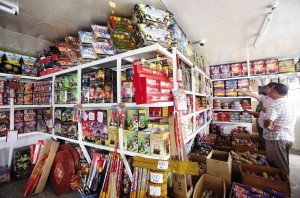5 days before New Year’s, ’cracker injuries soar to 113
MANILA, Philippines – Less than a week before the New Year’s Eve revelry, the Department of Health reported Saturday that there were already 113 firework-related injuries across the country.
The figure included the first case of firework ingestion involving a 5-year-old boy in San Mateo, Rizal, who mistook a piece of “luces” for a candy.
Two other victims, a 5-year-old boy in Cebu and a 9-year-old boy in Manila, both lost a hand to firecrackers.
The boy from Manila lost his left hand after igniting a piccolo, a small, inexpensive and colorful firecracker lighted like a matchstick.
Majority or 75 cases (67 percent) were caused by piccolo, according to the DOH firecracker injury registry, which started last Dec. 21 its monitoring of firework-related casualties.
The boy in Cebu reportedly lost his right hand due to a still unknown firecracker.
While the nationwide tally was 86 cases or 43 percent lower compared to the same period last year, DOH still found the trend unacceptable, especially in light of injuries with permanent consequences.
“Every life is important,” said acting Health Secretary Janette Loreto-Garin in a statement.
“The lower number of cases only encourages DOH to intensify its campaign to stop the use of firecrackers in merry-making to welcome the New Year,” she said.
In its 6 a.m. firecracker injury registry update, the DOH’s National Epidemiology Center also indicated the nationwide tally is 50 cases (31 percent) lower than the five-year (2009-2013) average.
The DOH’s label “firework-related injuries” includes direct firework injuries, firework ingestion, and stray bullet injuries.
Of the 112 cases of direct fireworks injuries, 96 (86 percent) involved males aged 3 to 68.
The DOH registry showed 39 cases (35 percent) involved children below 10 years old.
Eighty-seven of the cases (78 percent) had blast injuries not requiring amputation, six cases (5 percent) of blast injury with amputation, and 19 cases (17 percent) sustained eye injury.
The National Capital Region represented 39 percent or 44 of the total 113 cases, with Manila having the most cases at 19, followed by Pasig with eight and Las Piñas and Pasay with three cases each.
Apart from piccolo, five star, camara, and boga also topped the list of injury-causing firecrackers in the December 27 registry.
Garin reiterated an earlier call she made to parents and caregivers of children to be more vigilant in protecting children from firecrackers.
“Children should be kept away from firecrackers, prevented from buying them, and sternly educated on their dangers,” she said.
“Imagine the rest of a child’s life without hands, arms, legs, or injured body parts after losing them to fireworks.… Not only is self-esteem drastically diminished, productivity at school will also be greatly affected,” she said in an earlier statement.
The DOH has partnered with the Department of Transportation and Communication, Ninoy Aquino International Airport, Philippine Ports Authority, Philippine National Railways, Light Railway Transit Authority, and the Philippine Information Agency to drive home its message on the life-threatening consequences of igniting firecrackers.
Governors, mayors, and other local government executives are being tapped to join the DOH anti-firecracker campaign.
“The DOH supports the growing public clamor for local governments to order firecracker bans. As in previous years, most cases to date come from the National Capital Region then followed by regions 10, 11 and 6. In the NCR, cases came from Manila, Pasig, Las Piñas and Pasay,” the DOH said.
The DOH has been encouraging the public to enjoy the holiday season by using safer alternatives to firecrackers.
The department urged the public to be part of the anti-firecracker advocacy by sharing the Iwas Paputok video now posted on social media sites such as Facebook, Twitter and YouTube.
In addition to the information drive, all health personnel in DOH offices, hospitals and medical centers are on Code White alert – they are on standby for the duration of the holiday season, prepared to provide assistance in treating victims of firecrackers.
“To the families unfortunate to experience firecracker injuries of loved ones, quick and decisive action will be most necessary. Injured family members should have their wounds cleaned with water and protected by sterile gauze bandages, and then immediately brought to hospitals for proper treatment. Medical personnel will do the necessary treatment of wounds, give anti-tetanus shots and antibiotics,” the DOH added.















